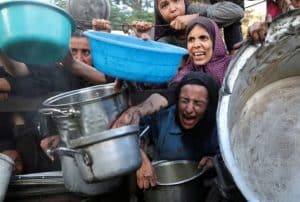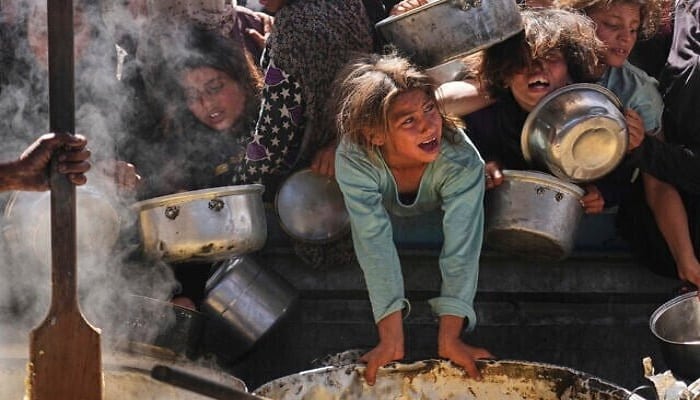PNN – Before the current war began, the Zionists had made precise calculations to determine the number of calories allowed to Gaza. The number of calories the Zionists intended would only allow the Palestinians to survive.
The images from Gaza these days show that death in Gaza has a thousand faces; one person is martyred by direct shelling in the areas where American-Zionist “humanitarian aid” is distributed; the other one who was holding a piece of bread dies. Another tries to reach a can of tuna, but is torn to pieces. Some are crushed under the feet of the living who fled the flames of the Zionist regime. The most cruel kind of death is weak ribs, rotten bones, and the gurgling sound of hundreds of thousands of empty stomachs.
The occupying regime in Jerusalem uses the policy of “starvation” as a fundamental tool to break the will of a nation; from seeds that are not allowed to enter, to fishing boats that are targeted at sea, and bakeries that are turned into military targets. The use of hunger as a weapon is not a new innovation or tool, but rather an extension of a colonial pattern deeply rooted in history. According to contemporary research in the field of biocolonial studies, control of vital resources, from water and food to seeds and soil, has been a central focus of colonial domination throughout history.
The world’s tables are full of food while there is nothing but hunger on the ground in Gaza and nothing but fire is raining from the sky. The children of Gaza, who are weaker and more vulnerable, are the main victims of the policy of hunger. The people of Gaza are similar not only in terms of patience and endurance, but also in terms of the level of death and constant hunger between the tents.
Calorie counting in Gaza
Hunger in Gaza has a long history. The 365-kilometer strip has been under Israeli siege since 2007. Leaked Israeli documents before the current war began show that the occupiers had made precise calculations to determine the number of calories allowed to Gaza. The number of calories the Zionists intended would allow the Palestinians to survive.
The nutritional equation in question reminds us of similar calculations made by colonial authorities throughout history to determine the minimum amount of food needed to keep workers capable of working. Caribbean sugar plantation owners meticulously calculated the amount of food needed to keep their “slave laborers” alive. Today, the same racist equation is being applied with more sophisticated tools and humanitarian justifications.
The question arises: why are the Israeli regime’s actions not limited to food entering Gaza, but also systematically targeting food production infrastructure such as farms, food factories, bakeries, and even olive trees?
The destruction carried out by the Zionist occupiers is intended not only to prevent current production, but also to ensure that it cannot be restored in the future; like historical colonial wars, destroying a population’s ability to feed itself is considered a more effective strategy than killing it outright.

The Legacy of the Mandate in Palestine
The continuity of colonial patterns of food is clearly visible in the history of Palestine. From the British Mandate to the Israeli occupation, the land has undergone fundamental transformations in agricultural and food systems, each serving a different but complementary colonial project.
The British Mandate not only laid the foundation for laws that redefined land ownership, but also created a complex network of laws that transformed traditional Palestinian agriculture into a system under central administrative control. According to studies, the Animal Diseases Act, which gave colonial authorities the right to control the movement of goods and animals, is a direct legacy of British mandate laws. It was incorporated into Israeli law in 1962 and represents a clear continuation of colonial legal processes.
These laws were not merely administrative documents but tools for reshaping the relationship between Palestinians and their land. The imposition of a system of permits and licenses, the restriction of the movement of animals and agricultural products, and the determination of the types of crops permitted for cultivation were all practices aimed at destroying the traditional Palestinian agricultural economy and subordinating it to the colonial authorities.
The Israeli occupation regime’s control over the Palestinian food system was not limited to preventing the flow of food during wartime, but included complete control over every stage of production and distribution; from the seeds that Palestinian farmers were allowed to use to the irrigation methods available, through transportation and marketing, and even the Palestinian table. Everything was under Zionist control. The entry of Palestinian products into the market was subject to severe restrictions under the pretext of “protecting public health and preventing the spread of disease.” However, numerous studies show that this justification is rooted in a long history of colonial exploitation of medical and scientific arguments to exclude and subjugate the other. The Palestinians, their plants, and their animals were seen as potential sources of contamination, justifying the imposition of severe restrictions on their movement and circulation.
Famine: A lesson from world history
The use of hunger as a “weapon of war” that we are witnessing today in the Gaza Strip has a sad historical precedent that reveals a pattern rooted in colonial practices. The Irish Potato Famine (1845-1852) is a prime example of how food was used as a tool for genocide. While other Irish crops were exported to England for profit, a million Irish people were starving to death and millions more were forced to emigrate.
The British government was not a passive spectator to this disaster; it played an active role in exacerbating it through its economic and administrative policies. The British Corn Laws prevented the import of cheap food, while food exports from Ireland continued. Degrading conditions were imposed on food aid, including forcing Irish people to work on useless projects in exchange for meager food rations.
In India, this disaster was repeated on a larger scale and with greater regularity. During the British Raj (British rule), India experienced more than twenty major famines that claimed the lives of tens of millions of Indians. The worst of these was the Bengal Famine of 1943, which is estimated to have killed three million people, even as Britain exported grain from India to support its war effort in World War II. Winston Churchill, the then British Prime Minister, rejected India’s requests for food aid, sarcastically stating: The famine is the Indians’ own fault, because they reproduce like rabbits. This racist comment revealed the colonial ideology that saw the colonized people as superfluous and self-sacrificing to serve imperial interests.

